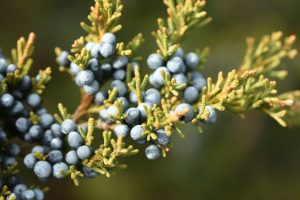Eastern Red Cedar, Juniperus virginiana

Photo by dogtooth77

Photo by John Ruter, University of Georgia, Bugwood.org

Photo by Karan A. Rawlins, University of Georgia, Bugwood.org
Height: 20 to 60 feet
Spread: 10 to 30 feet
LANDSCAPE USE
Used as a specimen tree, in groves, and to provide cover, food, and nest sites for birds and other wildlife. Especially useful along streets, on roadsides, in cemeteries, and as a tall, thick hedge along property borders.
FORM
An erect, conical, densely foliated, very low-branching, evergreen tree.
NATIVE RANGE
Pioneering in disturbed sites, along fields, and on roadsides. Throughout eastern North America, southward to central peninsular Florida.
CHARACTERISTICS
Leaves: Small, green, scalelike, crowded around the twigs and branches.
Fruit: Borne in bluish, rounded, berrylike female cones that are produced in profuse, showy clusters in late summer and fall. Male cones yellowish.
Bark: Reddish brown; exfoliating in thin, shaggy strips.
CULTURE
Soil: Especially well adapted to neutral and alkaline soils, but will adapt to almost any soil. Preferred pH 5.0-8.0. Salt tolerant.
Exposure: Full sun.
Water: Drought tolerant. Irrigation typically not required. Site should be well drained.
Hardiness Zones: 3 to 9.
Life Span: Long-lived.
BEST FEATURES including WILDLIFE SUPPORT
Evergreen habit, conical shape, dense foliage, bluish female cones, usefulness to wildlife, and exceptional tolerance of alkaline soil. The dense growth habitat is really good for bird cover. Cedar Waxwings and other birds eat the berries (female trees). This tree is a host for Hairstreak butterfly larvae and many moths which are in turn good food for birds.
COMPANION PLANTS
Live Oak and Sand Live Oak (Quercus virgirniana and Q. geminata), American Holly (Ilex opaca), Coontie (Zamia pumila), Yaupon (Ilex vomitoria), Fringetree (Chionanthus virginicus), American Hop Hornbeam (Ostrya virginiana), Blue Beech or Hornbeam (Carpinus caroliniana), Redbud (Cercis canadensis), Witch Hazel (Hamamelis virginiana), Needle Palm (Rhapidophyllum hystrix), Winged Elm (Ulmus alata).
DISADVANTAGES
Susceptible to a number of insect pests. Host of cedar-apple rust; should not be grown near Crabapple (Malus angustifolia) or Haws (Crataegus spp.).
CULTIVARS
A number of Red Cedar cultivars have been selected, but none are much used in Florida.
ALLERGENIC AND TOXIC PROPERTIES
May cause dermatitis in some people and digestive upset to cattle; airborne pollen may cause respiratory problems in some people.
SIMILAR AND RELATED SPECIES
FANN recognizes Southern Red Cedar (J. silicicola) as a distinct species.